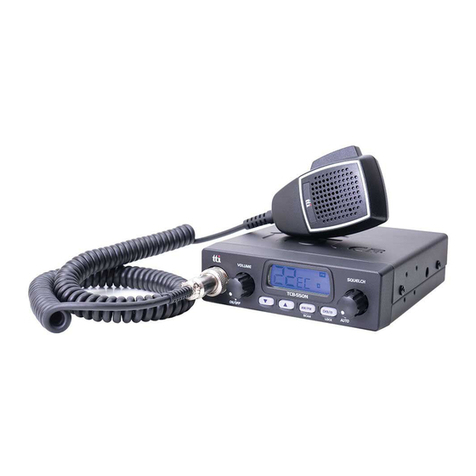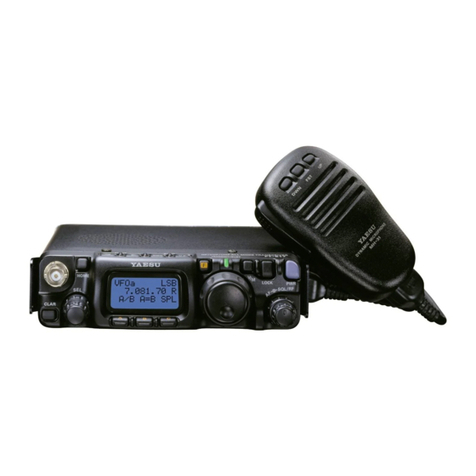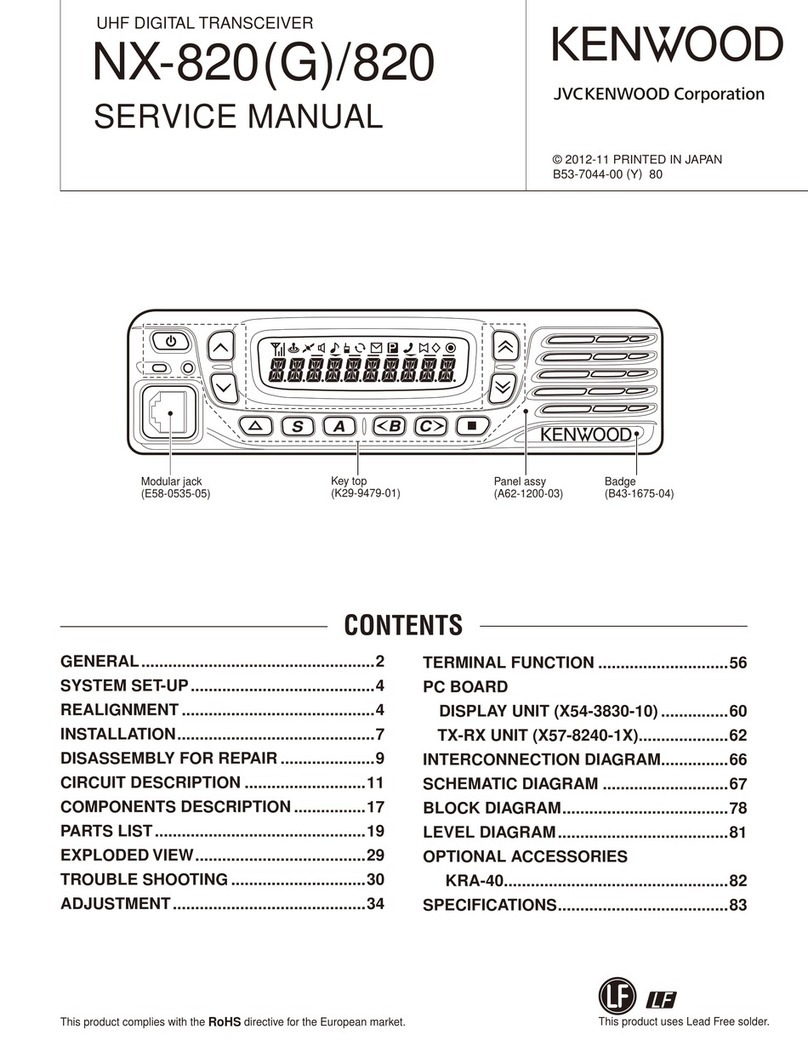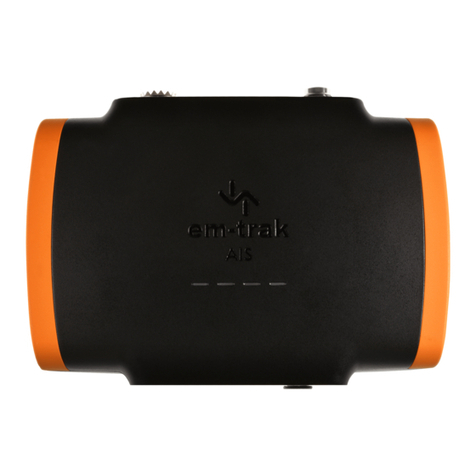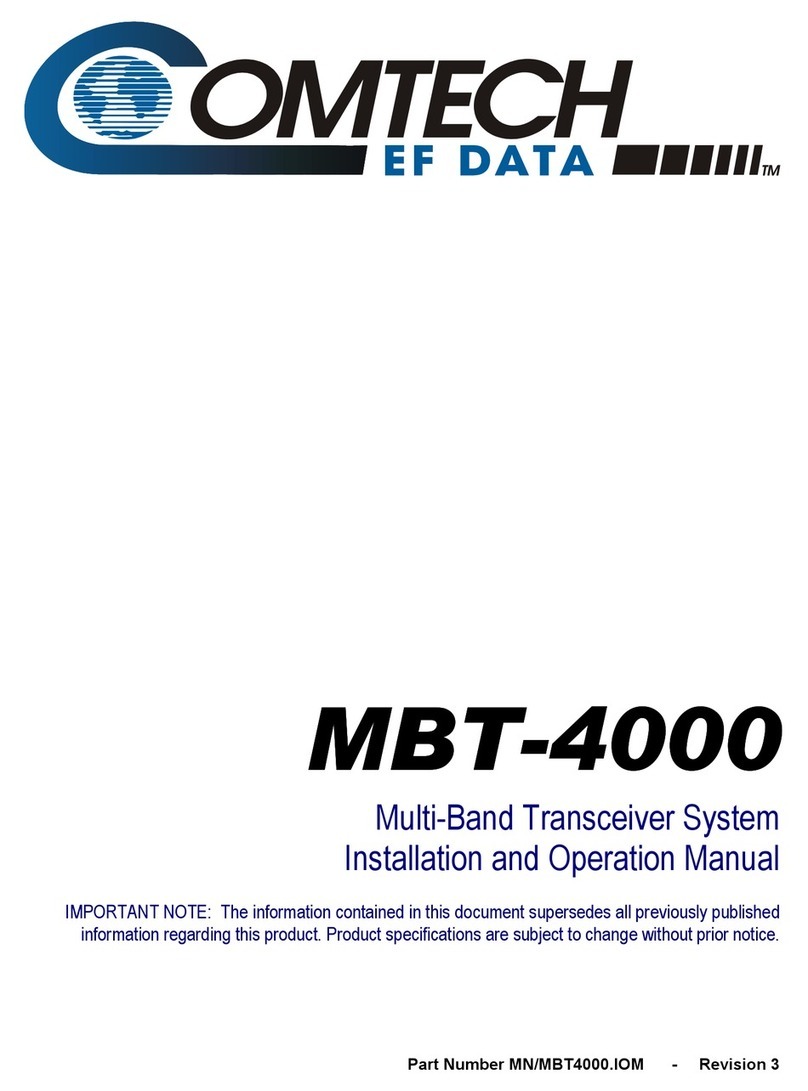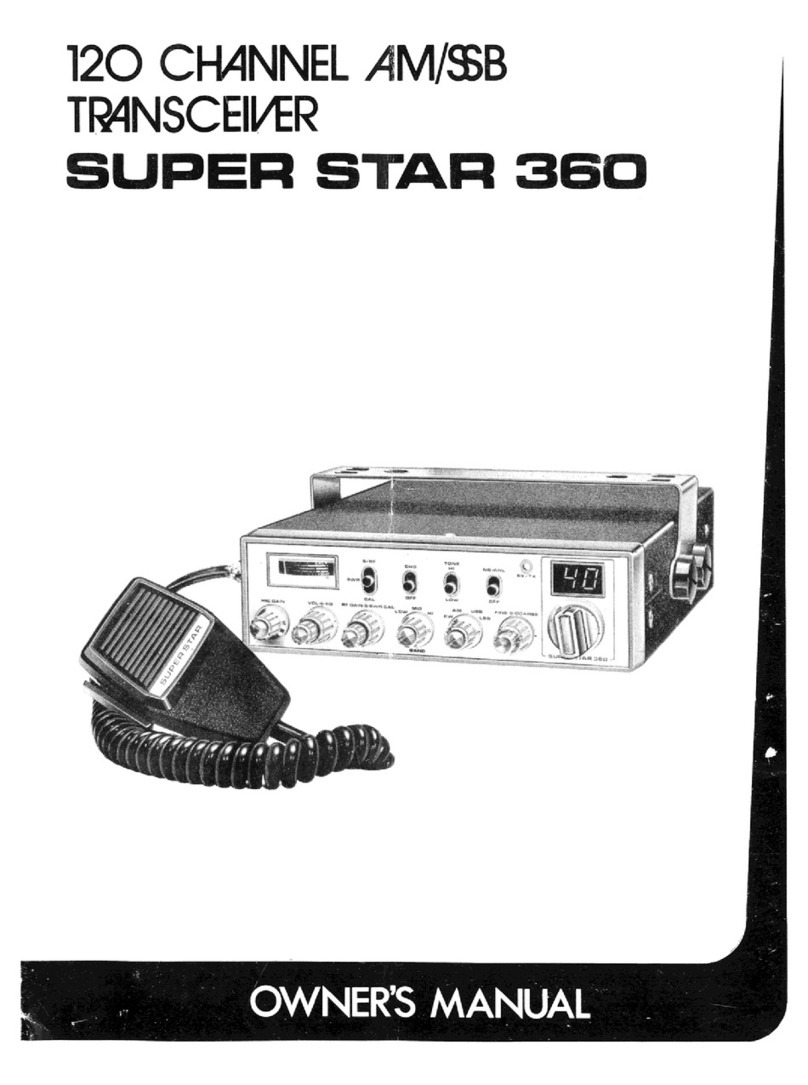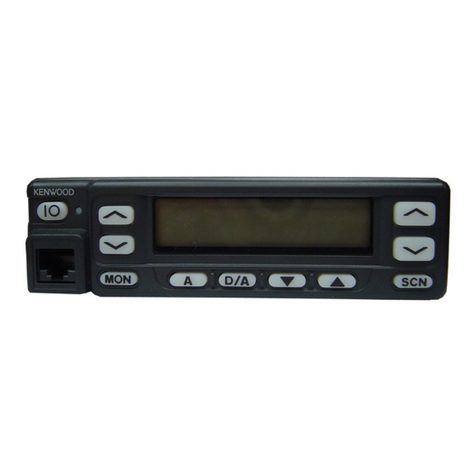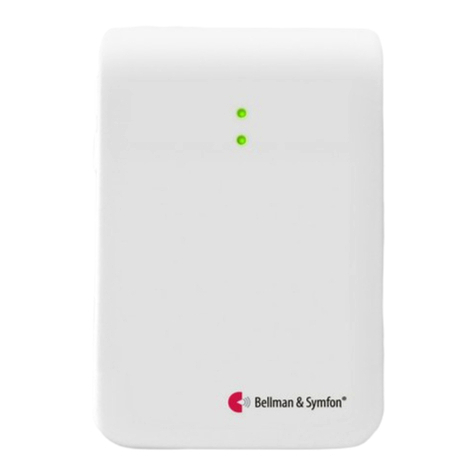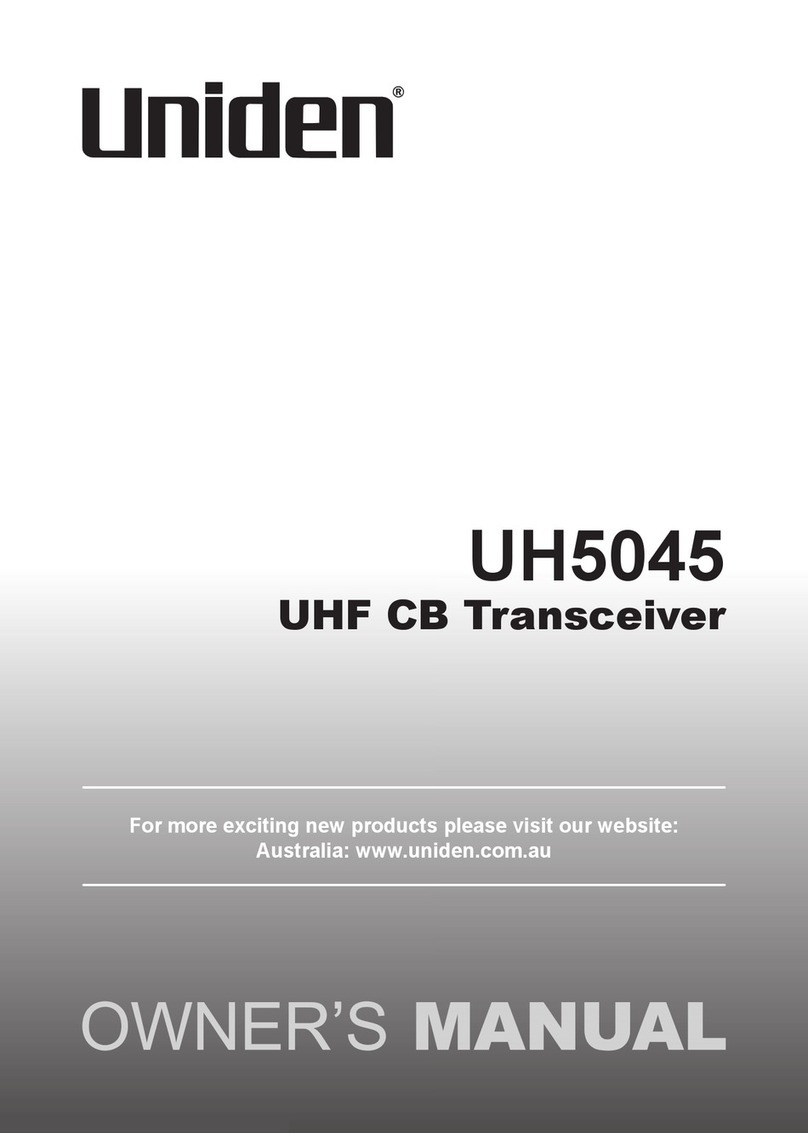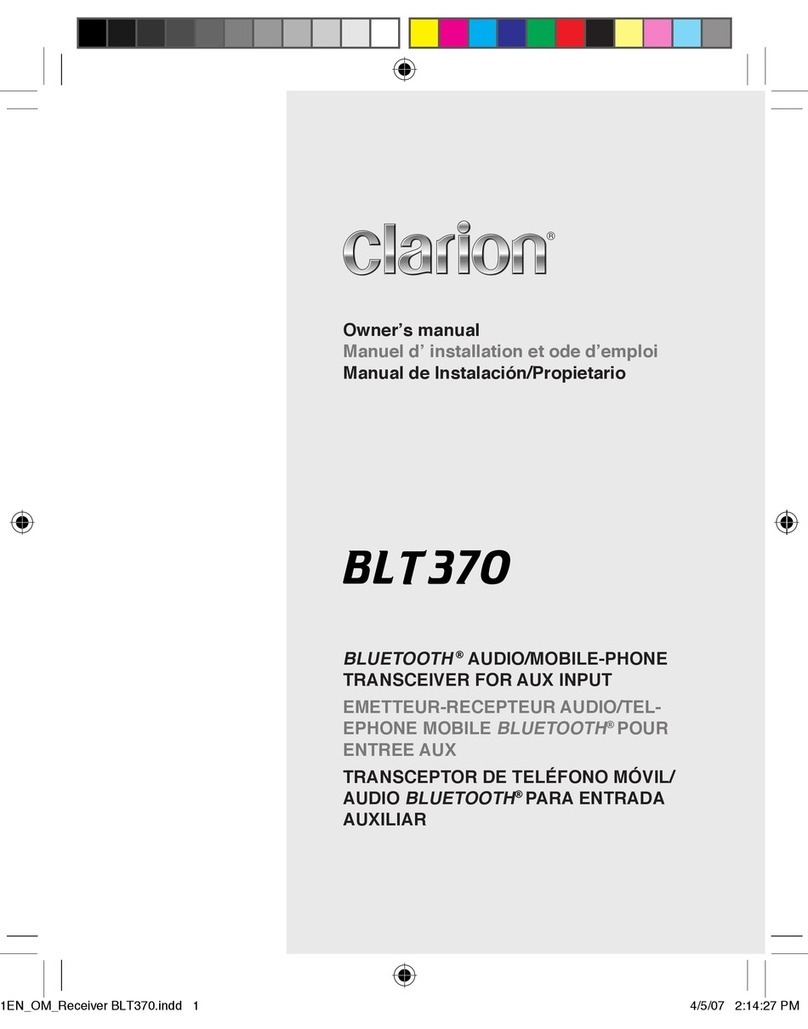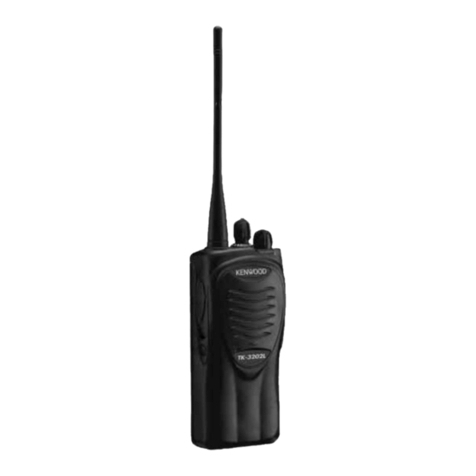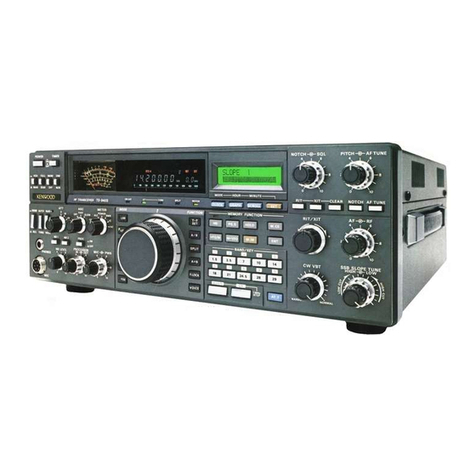Silicon Laboratories Si4455 Series User manual

Rev 1.1 10/13 Copyright © 2013 by Silicon Laboratories Si4455
Si4455
EASY-TO-USE, LOW-CURRENT OOK/(G)FSK SUB-GHZ
TRANSCEIVER
Features
Applications
Description
Silicon Laboratories’ Si4455 is an easy-to-use, low current, sub-GHz
EZRadio®transceiver. Covering all major bands, it combines
plug-and-play simplicity with the flexibility needed to handle a wide variety
of applications. The compact 3x3 mm package size combined with a low
external BOM count makes the Si4455 both space efficient and cost
effective. The +13 dBm output power and excellent sensitivity of
–116 dBm allows for a longer operating range, while the low current
consumption of 18 mA TX (at 10 dBm), 10 mA RX, and 50 nA standby,
provides for superior battery life. By fully integrating all components from
the antenna to the GPIO or SPI interface to the MCU, the Si4455 makes
realizing this performance in an application easy. Design simplicity is
further exemplified in the Wireless Development Suite (WDS) user
interface module. This configuration module provides simplified
programming options for a broad range of applications in an easy to use
format that results in both a faster and lower risk development. The
Si4455 is capable of supporting major worldwide regulatory standards
such as FCC, ETSI, ARIB and China regulatory standards.
Frequency
range = 283–960 MHz
Receive
sensitivity = –116 dBm
Modulation
(G)FSK
OOK
Max output power = +13 dBm
Low active power consumption
10 mA RX
18 mA TX @ +10 dBm
Low standby current = 50 nA
Max data rate = 500 kbps
Power supply = 1.8 to 3.6 V
TX and RX 64 byte FIFOs
Automatic frequency control (AFC)
Automatic gain control (AGC)
Integrated battery voltage sensor
Packet handling including
preamble, sync word detection, and
CRC
Low BOM
20-Pin 3x3 mm QFN package
Remote control
Home security and alarm
Telemetry
Garage and gate openers
Remote keyless entry
Home automation
Industrial control
Sensor networks
Health monitors
Patents pending
Pin Assignments
1
2
3
4
5
678910
16
15
14
13
12
11
20 19 18 17GND
SDN
RXp
RXn
TX
GND
nSEL
SDI
SDO
SCLK
nIRQ
GPIO1
VDD
VDD
GND
GPIO0
GPIO3
GPIO2
XIN
XOUT
Si4455

Si4455
2 Rev 1.1
Functional Block Diagram
Rx/Tx
Modem
Synthesizer
LNA PGA ADC
Rx Chain
PA
SPI Interface
Controller
Battery
Voltage
Sensor
Aux ADC
25-32MHz XO
SDN
RXp
RXn
TX
VDD GPIO0
GPIO1
nSEL
SDI
SDO
SCLK
nIRQ
XOUTXINGPIO2GPIO3

Si4455
Rev 1.1 3
TABLE OF CONTENTS
Section Page
1. Electrical Specifications . . . . . . . . . . . . . . . . . . . . . . . . . . . . . . . . . . . . . . . . . . . . . . . . . . .4
1.1. Definition of Test Conditions . . . . . . . . . . . . . . . . . . . . . . . . . . . . . . . . . . . . . . . . . . .11
2. Typical Applications Schematic . . . . . . . . . . . . . . . . . . . . . . . . . . . . . . . . . . . . . . . . . . . .12
3. Functional Description . . . . . . . . . . . . . . . . . . . . . . . . . . . . . . . . . . . . . . . . . . . . . . . . . . .13
3.1. Receiver Chain . . . . . . . . . . . . . . . . . . . . . . . . . . . . . . . . . . . . . . . . . . . . . . . . . . . . .14
3.2. Receiver Modem . . . . . . . . . . . . . . . . . . . . . . . . . . . . . . . . . . . . . . . . . . . . . . . . . . . .14
3.3. Synthesizer . . . . . . . . . . . . . . . . . . . . . . . . . . . . . . . . . . . . . . . . . . . . . . . . . . . . . . . .15
3.4. Transmitter . . . . . . . . . . . . . . . . . . . . . . . . . . . . . . . . . . . . . . . . . . . . . . . . . . . . . . . .16
3.5. Crystal Oscillator . . . . . . . . . . . . . . . . . . . . . . . . . . . . . . . . . . . . . . . . . . . . . . . . . . . .17
3.6. Battery Voltage and Auxiliary ADC . . . . . . . . . . . . . . . . . . . . . . . . . . . . . . . . . . . . . .17
4. Configuration Options and User Interface . . . . . . . . . . . . . . . . . . . . . . . . . . . . . . . . . . . .18
4.1. Radio Configuration Application (RCA) GUI . . . . . . . . . . . . . . . . . . . . . . . . . . . . . . .18
4.2. Configuration Options . . . . . . . . . . . . . . . . . . . . . . . . . . . . . . . . . . . . . . . . . . . . . . . .19
4.3. Configuration Commands . . . . . . . . . . . . . . . . . . . . . . . . . . . . . . . . . . . . . . . . . . . . .21
5. Controller Interface . . . . . . . . . . . . . . . . . . . . . . . . . . . . . . . . . . . . . . . . . . . . . . . . . . . . . .22
5.1. Serial Peripheral Interface . . . . . . . . . . . . . . . . . . . . . . . . . . . . . . . . . . . . . . . . . . . . .22
5.2. Operating Modes and Timing . . . . . . . . . . . . . . . . . . . . . . . . . . . . . . . . . . . . . . . . . .24
5.3. Interrupts . . . . . . . . . . . . . . . . . . . . . . . . . . . . . . . . . . . . . . . . . . . . . . . . . . . . . . . . . .29
5.4. GPIO . . . . . . . . . . . . . . . . . . . . . . . . . . . . . . . . . . . . . . . . . . . . . . . . . . . . . . . . . . . . .30
6. Data Handling and Packet Handler . . . . . . . . . . . . . . . . . . . . . . . . . . . . . . . . . . . . . . . . . .31
6.1. RX and TX FIFOs . . . . . . . . . . . . . . . . . . . . . . . . . . . . . . . . . . . . . . . . . . . . . . . . . . .31
6.2. Packet Handler . . . . . . . . . . . . . . . . . . . . . . . . . . . . . . . . . . . . . . . . . . . . . . . . . . . . .31
6.3. Direct Mode . . . . . . . . . . . . . . . . . . . . . . . . . . . . . . . . . . . . . . . . . . . . . . . . . . . . . . . .31
7. Pin Descriptions . . . . . . . . . . . . . . . . . . . . . . . . . . . . . . . . . . . . . . . . . . . . . . . . . . . . . . . . .32
8. Ordering Information . . . . . . . . . . . . . . . . . . . . . . . . . . . . . . . . . . . . . . . . . . . . . . . . . . . . .34
9. Package Outline . . . . . . . . . . . . . . . . . . . . . . . . . . . . . . . . . . . . . . . . . . . . . . . . . . . . . . . . .35
10. PCB Land Pattern . . . . . . . . . . . . . . . . . . . . . . . . . . . . . . . . . . . . . . . . . . . . . . . . . . . . . . .37
11. Top Marking . . . . . . . . . . . . . . . . . . . . . . . . . . . . . . . . . . . . . . . . . . . . . . . . . . . . . . . . . . .38
11.1. Si4455 Top Marking . . . . . . . . . . . . . . . . . . . . . . . . . . . . . . . . . . . . . . . . . . . . . . . .38
11.2. Top Marking Explanation . . . . . . . . . . . . . . . . . . . . . . . . . . . . . . . . . . . . . . . . . . . .38
Document Change List . . . . . . . . . . . . . . . . . . . . . . . . . . . . . . . . . . . . . . . . . . . . . . . . . . . . .39
Contact Information . . . . . . . . . . . . . . . . . . . . . . . . . . . . . . . . . . . . . . . . . . . . . . . . . . . . . . . .40

Si4455
4 Rev 1.1
1. Electrical Specifications
Table 1. Recommended Operating Conditions
Parameter Symbol Test Condition Min Typ Max Unit
Ambient Temperature TA–40 25 85 °C
Supply Voltage VDD 1.8 3.6 V
I/O Drive Voltage VGPIO 1.8 3.6 V
Table 2. DC Characteristics*
Parameter Symbol Test Condition Min Typ Max Unit
Supply Voltage Range VDD 1.8 3.3 3.6 V
Power Saving Modes IShutdown
RC oscillator, main digital regulator, and low
power digital regulator OFF. —30—nA
IStandby Register values maintained. — 50 — nA
IReady
Crystal Oscillator and Main Digital Regulator ON,
all other blocks OFF. —2—mA
ISPI Active SPI active state 1.35 mA
TUNE Mode Current ITune_RX RX Tune — 6.5 — mA
ITune_TX TX Tune — 6.9 — mA
RX Mode Current IRX —10—mA
TX Mode Current ITX +10 dBm output power, 868 MHz — 18 — mA
+13 dBm output power, 868 MHz — 30 — mA
*Note: All specifications are guaranteed by production test unless otherwise noted. Production test conditions and max limits
are listed in section "1.1. Definition of Test Conditions" on page 11.

Si4455
Rev 1.1 5
Table 3. Synthesizer AC Electrical Characteristics1
Parameter Symbol Test Condition Min Typ Max Unit
Synthesizer Frequency
Range
FSYN 283 — 350 MHz
425 — 525 MHz
850 — 960 MHz
Synthesizer Frequency
Resolution2
FRES-960 850–960 MHz —114.4— Hz
FRES-525 425–525 MHz —57.2—Hz
FRES-350 283–350 MHz —38.1—Hz
Notes:
1. All specifications guaranteed by production test unless otherwise noted. Production test conditions and max limits are
listed in section "1.1. Definition of Test Conditions" on page 11.
2. Guaranteed by qualification. Qualification test conditions are listed in section "1.1. Definition of Test Conditions" on
page 11.

Si4455
6 Rev 1.1
Table 4. Receiver AC Electrical Characteristics1
Parameter Symbol Test Condition Min Typ Max Unit
RX Frequency
Range
FRX 283 — 350 MHz
425 — 525 MHz
850 — 960 MHz
RX Sensitivity PRX-_2 (BER < 0.1%)
(2.4 kbps, GFSK, BT = 0.5,
F = 30 kHz, 114 kHz Rx BW)2
—–116—dBm
PRX-_40 (BER < 0.1%)
(40 kbps, GFSK, BT = 0.5,
F = 25 kHz, 114 kHz Rx BW)2
—–108—dBm
PRX-_128 (BER < 0.1%)
(128 kbps, GFSK, BT = 0.5,
F = 70 kHz, 305 kHz Rx BW)2
—–103—dBm
PRX-_OOK (BER < 0.1%, 1 kbps, 185 kHz Rx BW,
OOK, PN15 data)2
—–113—dBm
(BER < 0.1%, 40 kbps, 185 kHz Rx BW,
OOK, PN15 data)2
—–102—dBm
RX Channel Bandwidth2BW 40 — 850 kHz
BER Variation vs Power
Level2
PRX_RES Up to +5 dBm Input Level — 0 0.1 ppm
RSSI Resolution RESRSSI —±0.5—dB
1-Ch Offset Selectivity2C/I1-CH Desired Ref Signal 3 dB above sensitiv-
ity, BER < 0.1%. Interferer is CW and
desired modulated with 1.2 kbps,
F = 5.2 kHz, GFSK with BT= 0.5,
RX BW = 58 kHz
channel spacing = 100 kHz
— –56 — dB
2-Ch Offset Selectivity2C/I2-CH — –59 — dB
Blocking 200 kHz–1 MHz 200KBLOCK Desired Ref Signal 3 dB above sensitiv-
ity, BER < 0.1%. Interferer is CW and
desired modulated with 1.2 kbps
F = 5.2 kHz GFSK with BT = 0.5,
RX BW = 58 kHz
— –58 — dB
Blocking 1 MHz Offset21MBLOCK — –61 — dB
Blocking 8 MHz Offset28MBLOCK — –79 — dB
Image Rejection2ImREJ Rejection at the image frequency
IF = 468 kHz
— –35 — dB
Spurious Emissions3POB_RX1 Measured at RX pins — –54 — dBm
Notes:
1. All specifications guaranteed by production test unless otherwise noted. Production test conditions and max limits are
listed in section "1.1. Definition of Test Conditions" on page 11.
2. Guaranteed by qualification. Qualification test conditions are listed in section "1.1. Definition of Test Conditions" on page
11.
3. Emissions specifications are based on frequency, matching components, and board layout.

Si4455
Rev 1.1 7
Table 5. Transmitter AC Electrical Characteristics1
Parameter Symbol Test Condition Min Typ Max Unit
TX Frequency Range FTX 283 — 350 MHz
425 — 525 MHz
850 — 960 MHz
(G)FSK Data Rate2DRFSK 1.0 — 500 kbps
OOK Data Rate2DROOK 0.5 — 120 kbps
Modulation Deviation
Range f960 850–960 MHz — — 500 kHz
f525 425–525 MHz — — 500 kHz
f350 283–350 MHz — — 500 kHz
Modulation Deviation
Resolution2FRES-960 850–1050 MHz —114.4— Hz
FRES-525 425–525 MHz —57.2— Hz
FRES-350 283–350 MHz —38.1— Hz
Output Power Range3PTX –40 — +13 dBm
TX RF Output Steps2PRF_OUT
Using switched current match within
6 dB of max power —0.1— dB
TX RF Output Level2
Variation vs. Temperature PRF_TEMP –40 to +85 C—1—dB
TX RF Output Level
Variation vs. Frequency2PRF_FREQ Measured across 902–928 MHz — 0.5 — dB
Transmit Modulation
Filtering2B*T Gaussian Filtering Bandwith Time
Product —0.5—
Spurious Emissions3
POB-TX1
POUT =+13dBm,
Frequencies < 1 GHz —–54—dBm
POB-TX2 1–12.75 GHz, excluding harmonics — –42 — dBm
Harmonics3P2HARM Using reference design TX matching
network and filter with max output
power. Harmonics reduce linearly with
output power.
—–42—dBm
P3HARM —–42—dBm
Notes:
1. All specifications guaranteed by production test unless otherwise noted. Production test conditions and max limits are
listed in the "Production Test Conditions" section in "1.1. Definition of Test Conditions" on page 11.
2. Guaranteed by qualification. Qualification test conditions are listed in the "Qualification Test Conditions" section in "1.1.
Definition of Test Conditions" on page 11.
3. Output power and emissions specifications are dependent on transmit frequency, matching components, and board
layout.

Si4455
8 Rev 1.1
Table 6. Auxiliary Block Specifications1
Parameter Symbol Test Condition Min Typ Max Unit
XTAL Range2XTALRANGE 25 — 32 MHz
30 MHz XTAL Start-Up time t30M Using XTAL and board layout in
reference design. Start-up time
will vary with XTAL type and
board layout.
—250— µs
30 MHz XTAL Cap
Resolution3
30MRES —70—fF
POR Reset Time tPOR —— 5ms
Notes:
1. All specifications guaranteed by production test unless otherwise noted. Production test conditions and max limits are
listed in the "Production Test Conditions" section in "1.1. Definition of Test Conditions" on page 11.
2. XTAL Range tested in production using an external clock source (similar to using a TCXO).
3. Guaranteed by qualification. Qualification test conditions are listed in the "Qualification Test Conditions" section in "1.1.
Definition of Test Conditions" on page 11.

Si4455
Rev 1.1 9
Table 7. Digital IO Specifications (GPIO_x, SCLK, SDO, SDI, nSEL, nIRQ)1
Parameter Symbol Test Condition Min Typ Max Unit
Rise Time TRISE 0.1 x VDD to 0.9 x VDD,
CL= 10 pF, DRV<1:0> = LL
VDD =3.3V
—2.3— ns
Fall Time TFALL 0.9 x VDD to 0.1 x VDD,
CL= 10 pF, DRV<1:0> = LL
VDD =3.3V
—2—ns
Input Capacitance CIN —2—pF
Logic High Level Input Voltage VIH VDD x0.7 — — V
Logic Low Level Input Voltage VIL ——V
DD x0.3 V
Input Current IIN 0<V
IN <V
DD –10 — 10 µA
Input Current if Pullup is Activated IINP VIL =0V 1 — 10 µA
Drive Strength for Output Low
Level2
IOmaxLL DRV[1:0] = LL — 6.66 — mA
IOmaxLH DRV[1:0] = LH — 5.03 — mA
IOmaxHL DRV[1:0] = HL — 3.16 — mA
IOmaxHH DRV[1:0] = HH — 1.13 — mA
Drive Strength for Output High
Level (GPIO1, GPIO2, GPIO3)2
IOmaxLL DRV[1:0] = LL — 5.75 — mA
IOmaxLH DRV[1:0] = LH — 4.37 — mA
IOmaxHL DRV[1:0] = HL — 2.73 — mA
IOmaxHH DRV[1:0] = HH — 0.96 — mA
Drive Strength for Output High
Level (GPIO0)2
IOmaxLL DRV[1:0] = LL — 2.53 — mA
IOmaxLH DRV[1:0] = LH — 2.21 — mA
IOmaxHL DRV[1:0] = HL — 1.7 — mA
IOmaxHH DRV[1:0] = HH — 0.80 — mA
Logic High Level Output Voltage VOH DRV[1:0] = HL VDD x0.8 — — V
Logic Low Level Output Voltage VOL DRV[1:0] = HL — — VDD x0.2 V
Notes:
1. All specifications guaranteed by qualification. Qualification test conditions are listed under “Qualification Test
Conditions” in "1.1. Definition of Test Conditions" on page 11.
2. GPIO output current measured at 3.3 VDC VDD with VOH = 2.64 VDC and VOL = 0.66 VDC.

Si4455
10 Rev 1.1
Table 8. Thermal Characteristics
Parameter Symbol Test Condition Max Value Unit
Thermal Resistance Junction to Ambient φJA Still Air 30 °C/W
Junction Temperature TJ92 °C
Table 9. Absolute Maximum Ratings
Parameter Value Unit
VDD to GND –0.3, +3.6 V
Voltage on Digital Control Inputs –0.3, VDD + 0.3 V
Voltage on Analog Inputs –0.3, VDD + 0.3 V
RX Input Power +10 dBm
Operating Ambient Temperature Range TA–40 to +85 C
Storage Temperature Range TSTG –55 to +125 C
Note: Stresses beyond those listed under “Absolute Maximum Ratings” may cause permanent damage to the device. These
are stress ratings only and functional operation of the device at or beyond these ratings in the operational sections of
the specifications is not implied. Exposure to absolute maximum rating conditions for extended periods may affect
device reliability. The Power Amplifier may be damaged if switched on without proper load or termination connected.
TX matching network design will influence TX VRF-peak on TX output pin. Caution: ESD sensitive device.

Si4455
Rev 1.1 11
1.1. Definition of Test Conditions
Production Test Conditions:
TA=+25°C
VDD =+3.3VDC
Sensitivity measured at 434 MHz using a PN15 modulated input signal and with packet handler mode
enabled.
External reference signal (XIN) = 1.0 VPP at 30 MHz, centered around 0.8 VDC
RF input and output levels can typically be achieved at the antenna port after filtering components.
Qualification Test Conditions:
TA= –40 to +85 °C (typical = 25 °C)
VDD = +1.8 to +3.6 VDC (typical = 3.3 VDC)
Use TX/RX Split Antenna reference design or production test schematic
RF input and output levels can typically be achieved at the antenna port after filtering components.

Si4455
12 Rev 1.1
2. Typical Applications Schematic
Figure 1. Si4455 Application Circuit
30 MHz
Microcontroller
GP1
GP2
GP3
GP4
C1
L1
L2
GND
GPIO1
19
18
17
16
1
2
3
4
15
14
13
7
8
9
10
SDI
SDO
SCLK
RXn
SDN
RXp
VDD
VDD
GPIO0
XIN
GPIO3
nSEL
XOUT
GND
5
TX
6
GND 20
GPIO2
11
12 GP5
L4 C2 Si4455 nIRQ
VDD
100 n
C8
100 p
C7
1u
L5
C6
C9
L3
C3
C4
C5
GP0
L6

Si4455
Rev 1.1 13
3. Functional Description
Figure 2. Si4455 Functional Block Diagram
The Si4455 is an easy-to-use, size efficient, low current wireless ISM transceiver that covers the sub-GHz bands.
The wide operating voltage range of 1.8–3.6 V and low current consumption make the Si4455 an ideal solution for
battery powered applications. The Si4455 operates as a time division duplexing (TDD) transceiver where the
device alternately transmits and receives data packets. The device uses a single-conversion mixer to downconvert
the FSK/GFSK or OOK/ASK modulated receive signal to a low IF frequency. Following a programmable gain
amplifier (PGA), the signal is converted to the digital domain by a high performance ADC allowing filtering,
demodulation, slicing, and packet handling to be performed in the built-in digital modem, increasing the receiver’s
performance and flexibility versus analog based architectures. The demodulated signal is output to the system
MCU through a programmable GPIO or via the standard SPI bus by reading the 64-byte Rx FIFO.
A single high-precision local oscillator (LO) is used for both transmit and receive modes since the transmitter and
receiver do not operate at the same time. The LO signal is generated by an integrated VCO and Fractional-N
PLL synthesizer. The synthesizer is designed to support configurable data rates up to 500 kbps. The Si4455
operates in the frequency bands of 283–350, 425–525, and 850–960 MHz. The transmit FSK data is modulated
directly into the data stream and can be shaped by a Gaussian low-pass filter to reduce unwanted spectral
content.
The Si4455 contains a power amplifier (PA) that supports output powers up to +13 dBm and is designed to support
single coin cell operation with current consumption of 18 mA for +10 dBm output power. The PA is single-ended to
allow for easy antenna matching and low BOM cost. The PA incorporates automatic ramp-up and ramp-down
control to reduce unwanted spectral spreading. Additional system features, such as 64-byte TX/RX FIFOs,
preamble detection, sync word detector, and CRC, reduce overall current consumption and allow for the use of
lower-cost system MCUs. Power-on-reset (POR) and GPIOs further reduce overall system cost and size. The
Si4455 is designed to work with an MCU, crystal, and a few passives to create a very compact and low-cost
system.
Rx/Tx
Modem
Synthesizer
LNA PGA ADC
Rx Chain
PA
SPI Interface
Controller
Battery
Voltage
Sensor
Aux ADC
25-32MHz XO
SDN
RXp
RXn
TX
VDD GPIO0
GPIO1
nSEL
SDI
SDO
SCLK
nIRQ
XOUTXINGPIO2GPIO3

Si4455
14 Rev 1.1
3.1. Receiver Chain
The internal low-noise amplifier (LNA) is designed to be a wideband LNA that can be matched with three external
discrete components to cover any common range of frequencies in the sub-GHz band. The LNA has extremely low
noise to suppress the noise of the following stages and achieve optimal sensitivity; therefore, no external gain or
front-end modules are necessary. The LNA has gain control, which is controlled by the internal automatic gain
control (AGC) algorithm. The LNA is followed by an I-Q mixer, filter, programmable gain amplifier (PGA), and ADC.
The I-Q mixers downconvert the signal to an intermediate frequency. The PGA then boosts the gain to be within
dynamic range of the ADC. The ADC rejects out-of-band blockers and converts the signal to the digital domain
where filtering, demodulation, and processing is performed. Peak detectors are integrated at the output of the LNA
and PGA for use in the AGC algorithm.
The RX and TX pins can be directly tied externally.
3.2. Receiver Modem
Using high-performance ADCs allows channel filtering, image rejection, and demodulation to be performed in the
digital domain, which allows for flexibility in optimizing the device for particular applications. The digital modem
performs the following functions:
Channel selection filter
Preamble detection
Invalid preamble detection
TX modulation
RX demodulation
Automatic Gain Control (AGC)
Automatic frequency compensation (AFC)
Radio signal strength indicator (RSSI)
Cyclic redundancy check (CRC)
The digital channel filter and demodulator are optimized for ultra-low-power consumption and are highly
configurable. Supported modulation types are GFSK, FSK, and OOK. The channel filter can be configured to
support bandwidths ranging from 850 kHz down to 40 kHz. A large variety of data rates are supported ranging from
0.5 kbps up to 500 kbps. The configurable preamble detector is used with the synchronous demodulator to improve
the reliability of the sync-word detection. Preamble detection can be skipped using only sync detection, which is a
valuable feature of the asynchronous demodulator when very short preambles are used. The received signal
strength indicator (RSSI) provides a measure of the signal strength received on the tuned channel. The resolution
of the RSSI is 0.5 dB. This high-resolution RSSI enables accurate channel power measurements for clear channel
assessment (CCA), carrier sense (CS), and listen before talk (LBT) functionality. A wireless communication
channel can be corrupted by noise and interference, so it is important to know if the received data is free of errors.
A cyclic redundancy check (CRC) is used to detect the presence of erroneous bits in each packet. A CRC is
computed and appended at the end of each transmitted packet and verified by the receiver to confirm that no
errors have occurred. The packet handler and CRC can significantly reduce the load on the system microcontroller,
allowing for a simpler and cheaper microcontroller. The digital modem includes the TX modulator, which converts
the TX data bits into the corresponding stream of digital modulation values to be summed with the fractional input
to the sigma-delta modulator. This modulation approach results in highly accurate resolution of the frequency
deviation. A Gaussian filter is implemented to support GFSK, considerably reducing the energy in adjacent
channels. The default bandwidth-time (BT) product is 0.5 for all programmed data rates.
3.2.1. Received Signal Strength Indicator
The received signal strength indicator (RSSI) is an estimate of the signal strength in the channel to which the
receiver is tuned. The RSSI measurement is done after the channel filter, so it is only a measurement of the
desired or undesired in-band signal power. The Si4455 uses a fast response register to read RSSI and so can
complete the read in 16 SPI clock cycles with no requirement to wait for CTS. The RSSI value reported by this API
command can be converted to dBm using the following equation:

Si4455
Rev 1.1 15
The value of 130 in the above formula is based on bench characterization of the EZRadio RF Pico boards
(evaluation boards). The RSSI value is latched at sync word detection and can be read via the fast response
register. The latched value of RSSI is available until the device re-enters Rx mode. In addition, the current value of
RSSI can be read out using the GET_MODEM_STATUS command. This can be used to implement CCA (clear
channel assessment) functionality. The user can set up an RSSI threshold value using the WDS Radio
Configuration Application GUI.
3.3. Synthesizer
The Si4455 includes an integrated Sigma Delta () Fractional-N PLL synthesizer capable of operating over the
bands from 283–350, 425–525, and 850–960 MHz. The synthesizer has many advantages; it provides flexibility in
choosing data rate, deviation, channel frequency, and channel spacing. The transmit modulation is applied directly
to the loop in the digital domain through the fractional divider, which results in very precise accuracy and control
over the transmit deviation. The frequency resolution is (2/3)Freq_xo/(219) for 283–350 MHz, Freq_xo/(219) for
425–525 MHz, and Freq_xo/(218) for 850–960 MHz. The nominal reference frequency to the PLL is 30 MHz, but
any XTAL frequency from 25 to 32 MHz may be used. The modem configuration calculator in WDS will
automatically account for the XTAL frequency being used. The PLL utilizes a differential LC VCO with integrated
on-chip inductors. The output of the VCO is followed by a configurable divider, which will divide the signal down to
the desired output frequency band.
3.3.1. Synthesizer Frequency Control
The frequency is set by changing the integer and fractional settings to the synthesizer. The WDS calculator will
automatically provide these settings, but the synthesizer equation is shown below for convenience. Initial
frequency settings are configured in the EZConfig setup and can also be modified using the API commands:
FREQ_CONTROL_INTE, FREQ_CONTROL_FRAC2, FREQ_CONTROL_FRAC1, and
FREQ_CONTROL_FRAC0.
Note: The fc_frac/219 value in the above formula must be a number between 1 and 2. The LSB of fc_frac must be "1".
3.3.1.1. EZ Frequency Programming
EZ frequency programming allows for easily changing radio frequency using a single API command. The base
frequency is first set using the EZConfig setup. This base frequency will correspond to channel 0. Next, a channel
step size is also programmed within the EZConfig setup. The resulting frequency will be:
The second argument of the START_RX or START_TX is CHANNEL, which sets the channel number for EZ
frequency programming. For example, if the channel step size is set to 1 MHz, the base frequency is set to
900 MHz, and a CHANNEL number of 5 is programmed during the START_TX command, the resulting frequency
will be 905 MHz. If no CHANNEL argument is written as part of the START_RX/TX command, it will default to the
previous value. The initial value of CHANNEL is 0 and so will be set to the base frequency if this argument is never
used.
Table 10. Output Divider (Outdiv) Values
Outdiv Lower (MHz) Upper (MHz)
12 284 350
8 425 525
4 850 960
RSSIdBm RSSI_value
2
---------------------------------130–=
RF frequency fc_inte fc_frac
219
------------------
+
4 freq_xo
outdiv
-------------------------------Hz=
RF Frequency Base Frequency Channel Step Size+=

Si4455
16 Rev 1.1
3.4. Transmitter
The Si4455 contains a +13 dBm power amplifier that is capable of transmitting from –40 to +13 dBm. The output
power set size is dependent on the power level and can be seen in Figure 3. The PA power level is set using the
API command: PA_PWR_LVL. The power amplifier is single-ended to allow for easy antenna matching and low
BOM cost. For detailed matching values, BOM, and performance expectations, refer to "AN686: Antennas for the
Si4455/4355 RF ICs". Power ramp-up and ramp-down is automatically performed to reduce unwanted spectral
spreading.
Figure 3. Tx Power vs PA_PWR_LVL and VDD

Si4455
Rev 1.1 17
3.5. Crystal Oscillator
The Si4455 includes an integrated crystal oscillator with a fast start-up time of less than 250 µs. The design is
differential with the required crystal load capacitance integrated on-chip to minimize the number of external
components. By default, all that is required off-chip is the crystal. The default crystal is 30 MHz, but the circuit is
designed to handle any XTAL from 25 to 32 MHz, set in the EZConfig setup. The crystal load capacitance can be
digitally programmed to accommodate crystals with various load capacitance and to adjust the frequency of the
crystal oscillator. The tuning of the crystal load capacitance is programmed through the GLOBAL_XO_TUNE API
property. The total internal capacitance is 11 pF and is adjustable in 127 steps (70 fF/step). The crystal frequency
adjustment can be used to compensate for crystal production tolerances. The frequency offset characteristics of
the capacitor bank are demonstrated in Figure 4.
Figure 4. Capacitor Bank Frequency Offset Characteristics
An external signal source can easily be used in lieu of a conventional XTAL and should be connected to the XIN
pin. The incoming clock signal is recommended to be ac-coupled to the XIN pin since the dc bias is controlled by
the internal crystal oscillator buffering circuitry. The input swing range should be between 600 mV–1.8 V
peak-to-peak. If external drive is desired, the incoming signal amplitude should not go below 0 V or exceed 1.8 V.
The best dc bias should be approximately 0.7 V. However, if the signal swing exceeds 1.4 Vpp, the dc bias can be
set to 1/2 the peak-to-peak voltage swing. The XO capacitor bank should be set to 0 whenever an external drive is
used on the XIN pin. In addition, the POWER_UP command should be invoked with the TCXO option whenever
external drive is used.
3.6. Battery Voltage and Auxiliary ADC
The Si4455 contains an integrated auxiliary 11-bit ADC used for the internal battery voltage detector or an external
component via GPIO. The Effective Number of Bits (ENOB) is 9 bits. When measuring external components, the
input voltage range is 1 V, and the conversion rate is between 300 Hz to 2.44 kHz. The ADC value is read by first
sending the GET_ADC_READING command and enabling the desired inputs. When the conversion is finished and
all the data is ready, CTS will go high, and the data can be read out. For details on this command and the formulas
needed to interpret the results, refer to the EZRadio API documentation zip file available from www.silabs.com.

Si4455
18 Rev 1.1
4. Configuration Options and User Interface
4.1. Radio Configuration Application (RCA) GUI
The Radio Configuration Application (RCA) GUI is part of the Wireless Development Suite (WDS) program. This
setup interface provides an easy path to quickly selecting and loading the desired configuration for the device. The
RCA allows for two different methods for device setup. One option is the configuration table, which provides a list of
preloaded, common configurations. A second option allows for custom configurations to be loaded. After the
desired configuration is selected, the RCA automatically creates the EZConfig configuration array that will be
passed to the chip for setup. The program then gives the option to load a sample project with the selected
configuration onto the evaluation board or launch IDE with the new configuration array preloaded into the user
program. For more information on EZConfig usage, refer to application note, “AN692: Si4355/Si4455 Programming
Guide”.
Figure 5. Device Configuration Options

Si4455
Rev 1.1 19
4.1.1. Configuration Table
The configuration table is a list of predefined configurations that have been optimized for performance and
validated by Silicon Labs. These configurations are listed for many common application conditions and so most
users will be able to find the configuration they need in this table. These configurations are set to provide optimized
performance for a given application and can be implemented with low design risk. Once the list item is selected,
the specific frequency, power level, and packet handler features can also be applied.
4.1.2. Radio Configuration Application
The Radio Configuration Application provides an intuitive interface for directly modifying the device configuration.
Using this control panel, the device parameters such as modulation type, data rate, frequency deviation, and any
packet related settings can be set. The program then takes these parameters and automatically determines the
appropriate device settings. This method allows the user to have complete flexibility in determining the
configuration of the device without the need to translate the system requirements into device specific properties.
The resulting configuration array is automatically generated and available for use in the user's program. The
resulting configuration array is obfuscated; therefore, its content changes every time a new array is generated,
even if the input parameters are the same.
4.2. Configuration Options
4.2.1. Frequency Band
The Si4455 can operate in the 283–350 MHz, 425–525 MHz, or 850–960 MHz bands. One of these three bands
will be selected during the configuration setup and then the specific transmission frequency that will be used within
this band can be selected.
4.2.2. Modulation Type
The Si4455 can operate using On/Off Keying (OOK), Frequency Shift Keying (FSK), or Gaussian Frequency Shift
Keying (GFSK). OOK modulation is the most basic modulation type available. It is the most power-efficient method
and does not require as high oscillator accuracy as FSK. FSK provides the best sensitivity and range performance,
but generally requires more precision from the oscillator used. GFSK is a version of FSK where the signal is
passed through a Gaussian filter, limiting its spectral width. As a result, the out-of-band components of the signal
are reduced.
The Si4455 also has an option for Manchester coding. This method provides a state transition at each bit and so
allows for more reliable clock recovery. Manchester code is available only when using the packet handler option
and, if selected, will be applied to the entire packet (the preamble pattern is set to continuous “1” if the Manchester
mode is enabled; therefore, the chip rate of the resulting preamble pattern is the same as for the rest of the packet).
The polarity can be configured to a “10” or “01”.
Figure 6. Manchester Code Example
11 111
000
Clock
Data
Manchester

Si4455
20 Rev 1.1
4.2.3. Frequency Deviation
If FSK or GFSK modulation is selected, then a frequency deviation will also need to be selected. The frequency
deviation is the maximum instantaneous difference between the FM modulated frequency and the nominal carrier
frequency. The Si4455 can operate across a wide range of data rates and frequency deviations. If a frequency
deviation needs to be selected, the following guideline might be helpful to build a robust link. A proper frequency
deviation is linked to the frequency error between transmitter and receiver. The frequency error can be calculated
using the crystal tolerance parameters and the RF operating frequency: (ppm_tx+ppm_rx)*Frf/1E-6. For frequency
errors below 50 kHz, the deviation can be about the same as the frequency error. For frequency errors exceeding
50 kHz, the frequency deviation can be set to about 0.75 times the frequency error. It is advised to position the
modulation index (= 2*freq_dev/data_rate) into a range between 1 and 100 for Packet Handling mode and 2 to 100
for direct mode (non-standard preamble). For example, when in Packet Handling mode and the frequency error is
smaller than data_rate/2, the frequency deviation is set to about data_rate/2. When the frequency error exceeds
100xdata_rate/2, the frequency deviation is preferred to be set to 100xdata_rate/2.
4.2.4. Data Rate
The Si4455 can be set to communicate at between 1 to 500 kbps in (G)FSK mode and between 0.5 to 120 kbps in
OOK mode. Higher data rates allow for faster data transfer while lower data rates result in improved sensitivity and
range performance.
4.2.5. Channel Bandwidth
The channel bandwidth sets the bandwidth for the receiver. Since the receiver bandwidth is directly proportional to
the noise allowed in the system, this will normally be set as low as possible. The specific channel bandwidth used
will usually be determined based upon the precision of the oscillator and the frequency deviation of the transmitted
signal. The RCA can provide the recommended channel bandwidth based upon these two parameters to help
optimize the system.
4.2.6. Preamble Length
A preamble is a defined simple bit sequence used to notify the receiver that a data transmission is imminent. The
length of this preamble will normally be set as short as possible to minimize power while insuring that it will be
reliably detected given the receiver characteristics, such as duty cycling and packet error rate performance. The
Si4455 allows the preamble length to be set between 0 to 255 bytes in length with a default length of 4 bytes. The
preamble pattern for the Si4455 will always be 55h with a first bit of "0" if the packet handler capability is used.
4.2.7. Sync Word Length and Pattern
The sync word follows the preamble in the packet structure and is used to identify the start of the payload data and
to synchronize the receiver to the transmitted bit stream. The Si4455 allows for sync word lengths of 1 to 4 bytes
and the specific pattern can be set within the RCA program. The default is a 2 byte length 2d d4 pattern.
4.2.8. Cyclic Redundancy Check
Cyclic Redundancy Check (CRC) is used to verify that no errors have occurred during transmission and the
received packet has exactly the same data as it did when transmitted. If this function is enabled in the Si4455, the
last byte of transmitted data must include the CRC generated by the transmitter. The Si4455 then performs a CRC
calculation on the received packet and compares that to the transmitted CRC. If these two values are the same, the
Si4455 will set an interrupt indicating a valid packet has been received and is waiting in the Rx FIFO. If these two
CRC values differ, the Si4455 will flag an interrupt indicating that a packet error occurred. The Si4455 uses
CRC(16)-IBM: x16+x15+x2+1 with a seed of 0xFFFF.
Other manuals for Si4455 Series
1
Table of contents
Other Silicon Laboratories Transceiver manuals
Silicon Laboratories
Silicon Laboratories Si4430 User manual
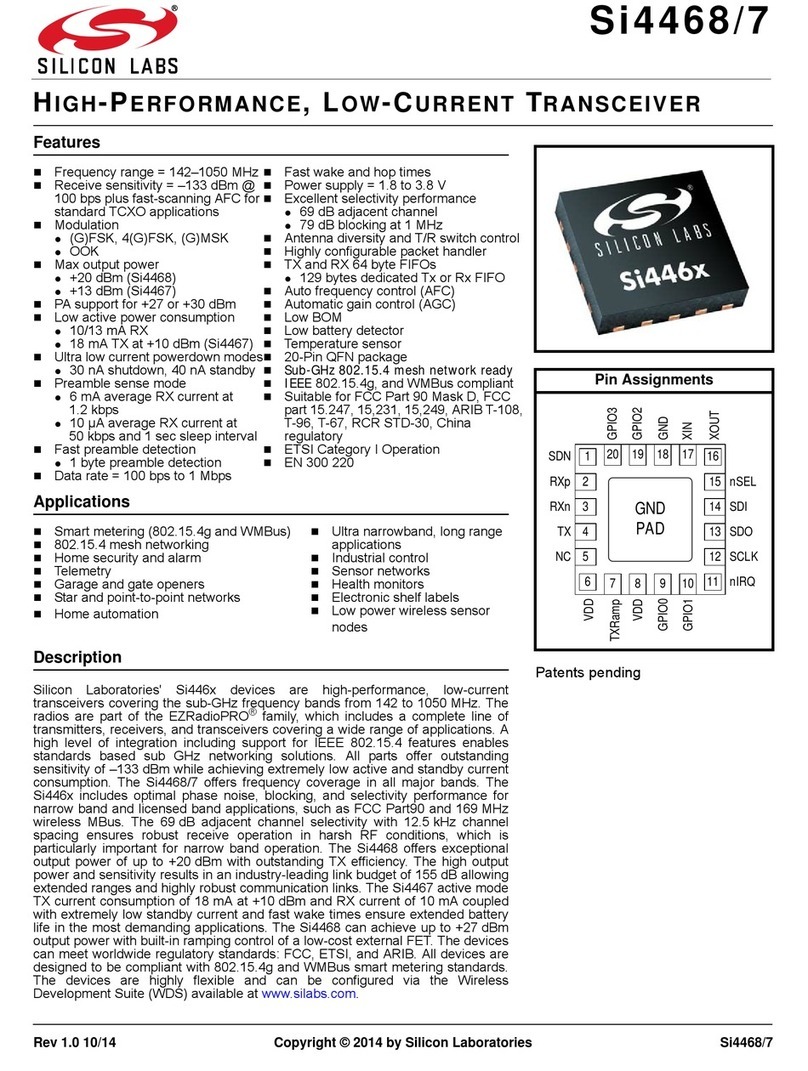
Silicon Laboratories
Silicon Laboratories Si4468/7 User manual
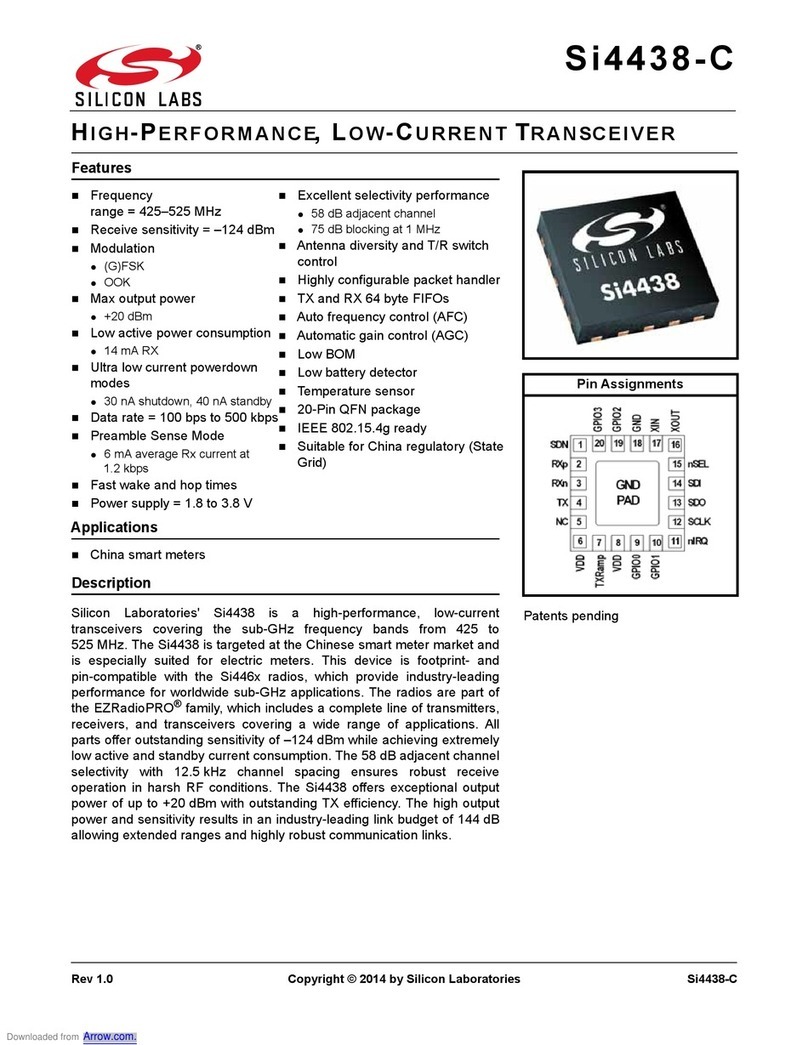
Silicon Laboratories
Silicon Laboratories Si4438-C User manual

Silicon Laboratories
Silicon Laboratories SI4421 User manual
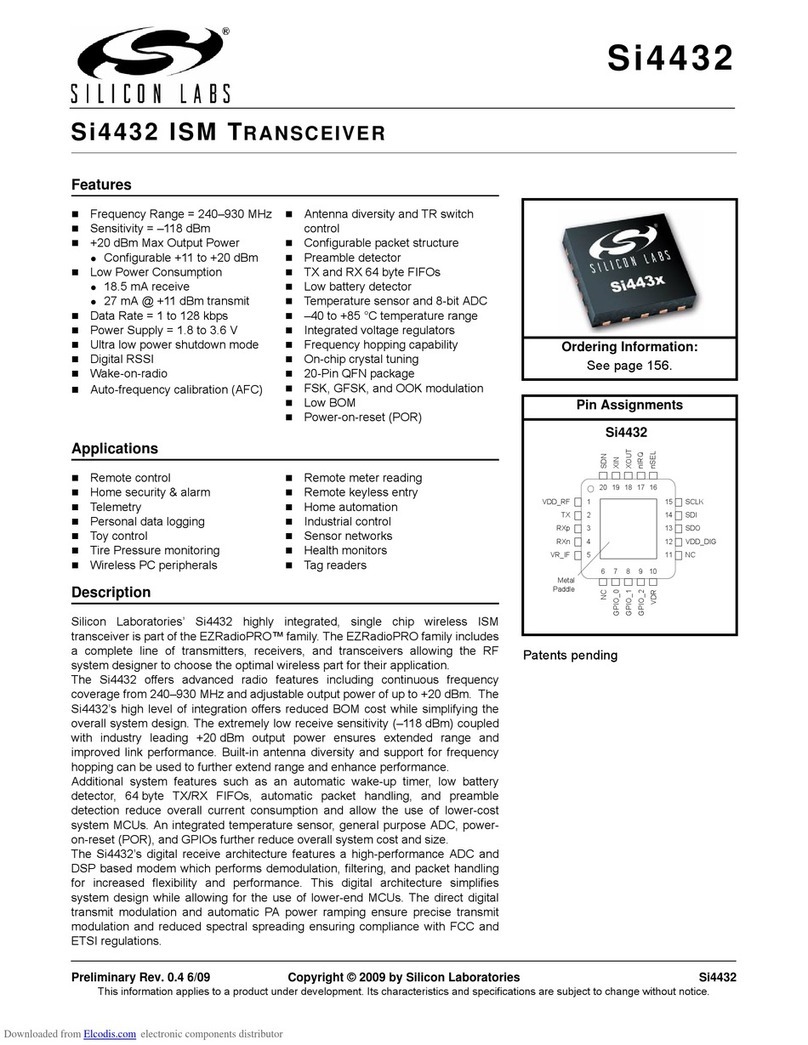
Silicon Laboratories
Silicon Laboratories Si4432 User manual
Silicon Laboratories
Silicon Laboratories EZRADIOPRO Si4438 User manual

Silicon Laboratories
Silicon Laboratories Si4355 Operating instructions

Silicon Laboratories
Silicon Laboratories Si4432 User manual
